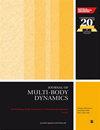双稳定接地非线性能量汇对系统能量耗散的影响
IF 1.9
4区 工程技术
Q3 ENGINEERING, MECHANICAL
Proceedings of the Institution of Mechanical Engineers Part K-Journal of Multi-Body Dynamics
Pub Date : 2021-10-14
DOI:10.1177/14644193211046094
引用次数: 3
摘要
本文对一种最有效的被动吸收器——非线性能量汇进行了分析研究。考虑一个两自由度系统,该系统由一个具有基本激励的线性振荡器(LO)和一个用非线性弹簧与地连接的称为接地NES (GNES)的NES组成。在这项研究中,我们提出了一种新的GNES位元排列方式,并研究了系统的不变流形,以及NES的能量吸收性能。考虑系统处于1:1共振附近,以研究强调制响应(SMR)。为此,在得到运动方程后,采用Manevitch复变量法和多尺度法对方程进行解析求解。然后,得到慢不变流形(SIM)。同时,通过时幅图计算网元的能量耗散比和网元瞬时总存储能量的百分比。结果表明,当非线性效应减小时,能量抽运发生的可能性减小。当激励幅值减小时,瞬时总能量在网内存储的百分比增大,能量耗散量也增大。本文章由计算机程序翻译,如有差异,请以英文原文为准。
Effects of bi-stable grounded nonlinear energy sink on energy dissipation of the system
In this paper, one of the most efficient passive absorbers, called nonlinear energy sink (NES), is analytically studied. A two-degree-of-freedom system is considered which consists of a linear oscillator (LO) with a base excitation and an NES, called grounded NES (GNES), which is connected to the ground with a nonlinear spring. In this study, we proposed a new arrangement of potential elements in GNES and studied invariant manifolds of the system, as well as the energy absorption performance of the NES. The system is considered in the vicinity of 1:1 resonance to investigate the strongly modulated response (SMR). To this end, after obtaining the equations of motion, the Manevitch complex variable and multiple scale method are applied to solve the equations, analytically. Then, the slow invariant manifold (SIM) is obtained. Also, the energy dissipation ratio of the NES and the percentage of the instantaneous total energy stored in the NES are calculated via the time-amplitude diagram. The results show that when the nonlinear effect decreases, the occurrence of energy pumping is less probable. Also, when the excitation amplitude decreases, the percentage of the instantaneous total energy stored in the NES increases as well as the amount of energy dissipation.
求助全文
通过发布文献求助,成功后即可免费获取论文全文。
去求助
来源期刊

CiteScore
4.10
自引率
11.10%
发文量
38
审稿时长
>12 weeks
期刊介绍:
The Journal of Multi-body Dynamics is a multi-disciplinary forum covering all aspects of mechanical design and dynamic analysis of multi-body systems. It is essential reading for academic and industrial research and development departments active in the mechanical design, monitoring and dynamic analysis of multi-body systems.
 求助内容:
求助内容: 应助结果提醒方式:
应助结果提醒方式:


